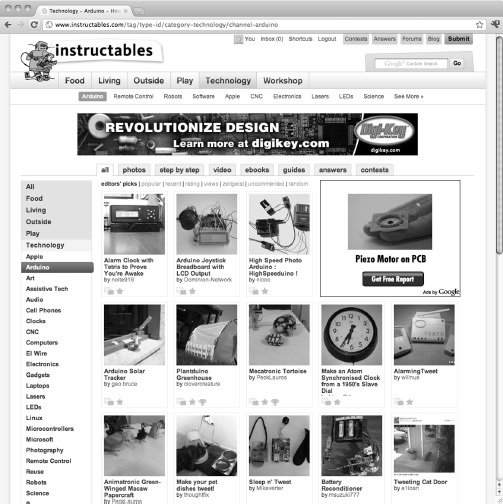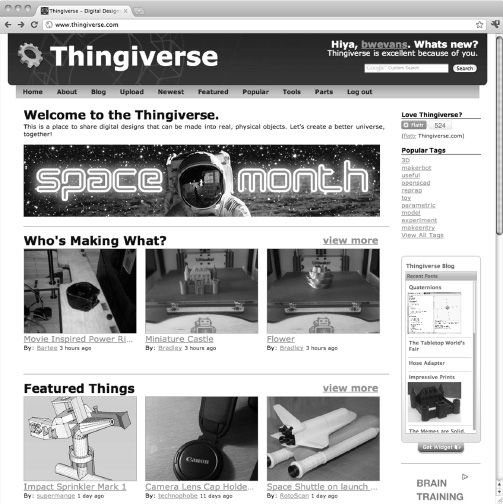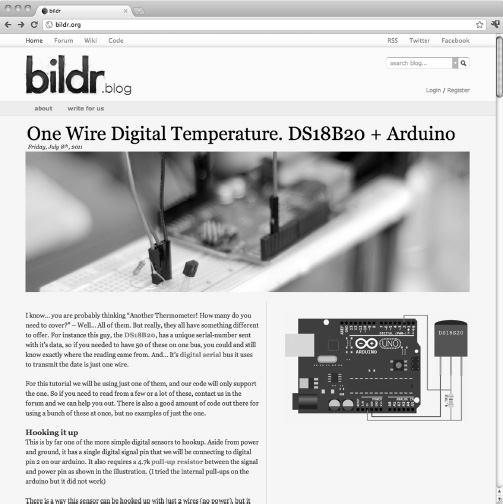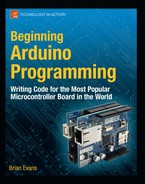Contribute to the Community
As we discussed way back in the first chapter, the Arduino community is one of the greatest strengths of the Arduino platform and constantly drives further improvement and development of the platform as a whole. Everyone needs a question answered at one point or another so one of the easiest ways to contribute back to the community is by being there with friendly advice on various online forums. Alternatively, just sharing the types of projects that you've made using the Arduino can provide inspiration and answers to someone that didn't even know they needed help. This section will provide a few specific ways that you can contribute back to the community—each one of these communities are not only a great place to share your projects, they are also a great place for getting inspired by new project ideas.
Participate in Online Forums
There are all sorts of online forums where all manner of makers post questions, share project ideas, suggest changes to the platform, and contribute to general discussions of all things Arduino. Nowhere is this more prevalent than straight from the source itself—the official Arduino forum at http://arduino.cc/forum/, shown in Figure 11-16.

With a multitude of categories for discussion and topics that range from electronics, programming, e-textiles, and even interactive art, there is always something to talk about on the Arduino forums. There are even international forums of a few different varieties. Sign up for a username so you can participate in the discussions and even use your username to contribute to the Arduino Playground, a wiki for contributed content at http://arduino.cc/playground/.
In addition to the main Arduino forum, two favorite retailers have very active communities in their forums as well. These include the forums of SparkFun Electronics and Adafruit Industries, listed in our Appendix. Because these forums are not exclusively limited to Arduino content, you never know what you might stumble onto. Who knows, you might find yourself drawn into making a new kind of digital clock or designing a Geiger counter. There are also forums galore for all sorts of projects that have derived from or are closely related to the Arduino project. Maybe you want to use the Arduino for 3D printing or maybe you need a little help picking up that new programming language, or maybe instead you are finally biting the bullet and want to program the AVR microcontrollers without Arduino's help. Whatever it is that you are into, these forums, also listed in the Appendix, are worthy of further investigation.
Publish Your Project
In addition to contributing to online forums, you could give back to the open-source hardware community by publishing your work in other venues. Simply blogging about your Arduino adventures or posting comments to social networking sites will help and inspire others to try out the Arduino platform. There are also other places that your projects could find a home. For example, you might want to post a how-to article on Instructables, the DIY collaboration site. The link to the dedicated Arduino channel, shown in Figure 11-17, is www.instructables.com/tag/type-id/category-technology/channel-arduino.

Figure 11-17. Instructables
Not only is Instructables a great place to share your projects, it is also pretty useful for finding answers to some unique problems. Another site for publishing and sharing projects that has gained a lot of ground especially with the 3D-printing crowd is Thingiverse, www.thingiverse.com, shown in Figure 11-18.

Thingiverse allows you to post a page on anything you make, including images of the finished thing, design files, source code, and instructions for assembly. This allows other users to build a copy of your thing and to even create a derivative of your thing if they make changes or improvements to your design. The centrality of the derivative on Thingiverse is fundamental to a community that encourages friendly reuse and remaking of just about anything that is posted.
If you've developed a neat, simple, modular circuit and some extensible code for the Arduino that can be made into other projects, you should try writing a tutorial for bildr at http://bildr.org (see Figure 11-19).

bildr is the place for short and simple tutorials that show how to build the parts that might be used in a larger project. It's a great resource for finding out how to connect a particular device and a little bit of code to get started with it. They are always looking for new writers, so as you learn how to connect new and interesting things to the Arduino, consider writing a tutorial to help others with that same gizmo.
